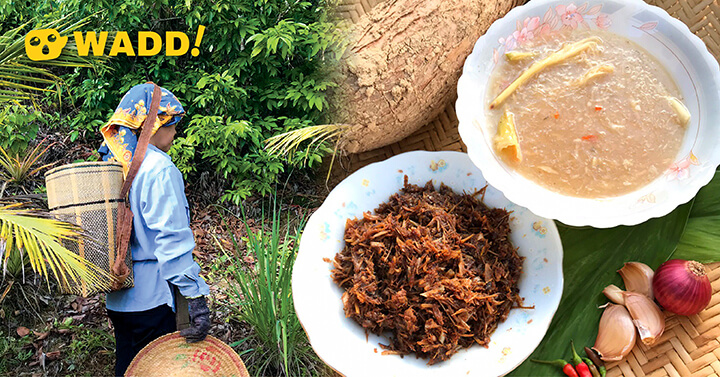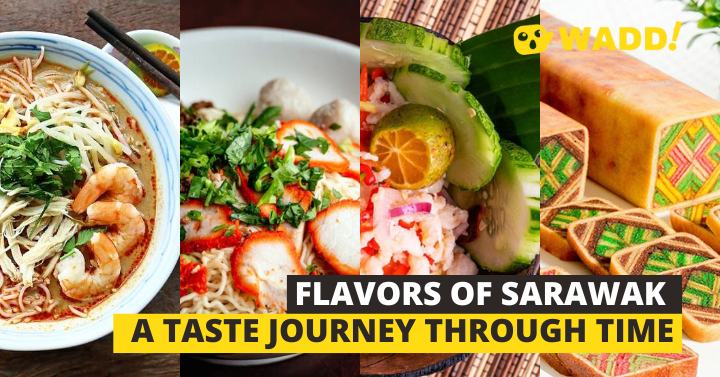There are more than 28 sub-ethnic groups in Sarawak, and Bidayuh is the 2nd largest ethnicity. Known as the Land Dayaks; the name Bidayuh means 'people of the land’. The term 'Land Dayak' was first used a term first used during the time of James Brooke, the first White Rajah (king) of Sarawak.
The Bidayuhs reside in the hilly mountainous forest in the olden days. Bidayuhs came mainly from the southern parts of Sarawak and Northern West Kalimantan.
There are many dialectical subgroups for this indigenous tribe, and they are categorised based on geographical areas such as Bau Jagoi from Penrissen, Padawan Bukar from Sadong and Selakau from Lundu. Each of their areas has unique dialects, customs, and beliefs.
For example, Bidayuh Bau alone has three sub-dialects with significant differences between them, and they are Jagoi, Serombu and Singgai, each corresponding to the areas they are located, surrounding the ancestral mountain.
On the whole, Bidayuh is known to be a simple, honest and hardworking community. Most were traditionally Pagans or animists but has converted to Christianity since the era of Brooke’s dynasty.
Like most ethnic groups in Sarawak, their traditional customs and practices were also significantly intertwined with their livelihood dependency on agriculture, especially hill paddy. Most were farmers, hunters, and gatherers; and ceremonies were held for land cultivation and fertility to ensure a bountiful harvest whether it be rice, sugarcane, pineapple, black pepper, or cocoa.
Hunters used to gather almost anything they can get their hands on. This includes some of the most exotic species like the pangolin (tenggiling), soft-shelled turtle (labi-labi), sago worms (sokot), wild boar (do’ot), local escargot (krumoi), etc. Most of which are now considered illegal to hunt. The gatherers also collected bee honey (pi’in bonyih) from the jungle that was made into a rice wine (tuak) too! Bidayuhs are good tuak masters. The flavour of the Bidayuh rice wine is slightly more subtle in comparison with the Iban rice wine. Bidayuhs also craft one of the best Sugar Cane Wine (Tuak Tobuh or Tepui).
Aside from their dialects and localities, another way to distinguish the tribe from other natives in Sarawak is through the distinctive motifs and designs on their traditional wear. This includes the patterns of young wild hairy ferns (pokuh kobuk) and bird eye (boton manuk puni).
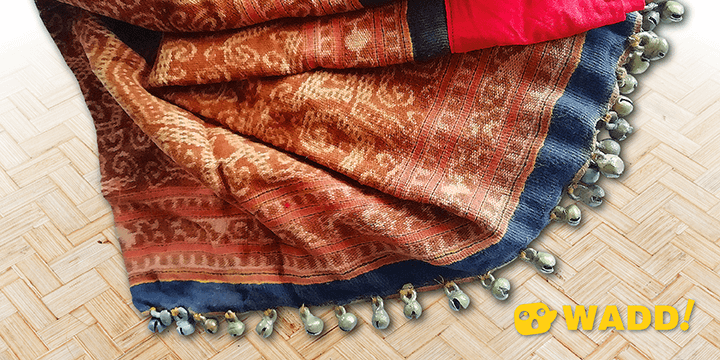
Pokuh kobuk patterns can typically be found on the woven or printed fabric (Jomuh Borih Birieh)
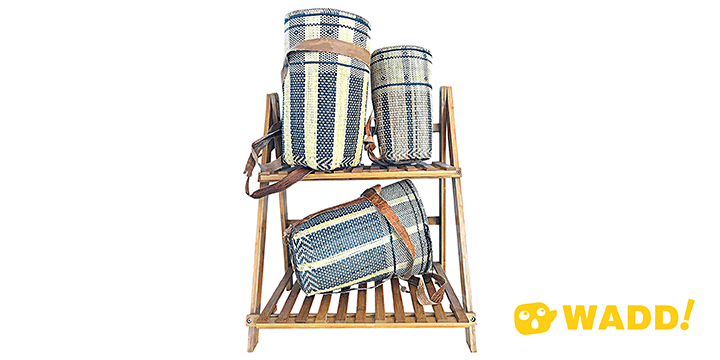
Juah – Bidayuh handwoven rattan basket with boton manuk puni design. These tall handmade baskets were used to carry harvested rice traditionally. Customarily, the Bidayuh Juah consists of only three colours. Added dye colours are from specific roots, leaves, or flowers.
Bidayuh is also well-known for their beautiful beadwork where you can find the boton manuk puni motif too. Pangiah (Jagoi dialect) is a multi-layered bead necklace consisting of four main colours namely red, black, white and blue.
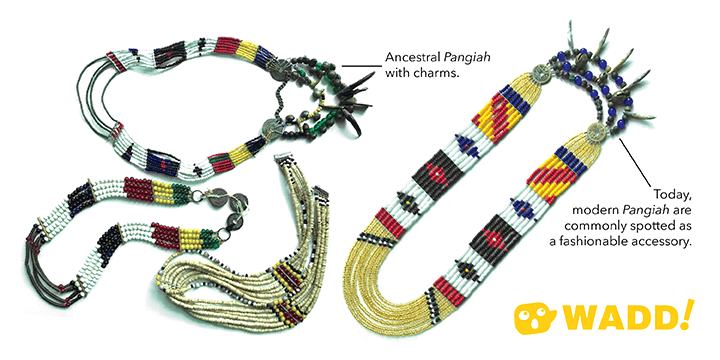
In the past, it was worn as a sacred item only by priestess (dayung borih) or women healer during a procession of healing, harvesting and other ceremonial occasions. It was believed that Pangiah has the power to gather spirits that could provide guidance and support to its wielders’ request.
INTO THE BIDAYUH KITCHEN
The Bidayuh is known for their fermented food (nobah). The art of fermentation is slowly diminishing in the community as there is barely any documentation on it, and only a handful has passed on the knowledge to the younger generation.
The Art of Fermentation
The general method of fermentation requires only the use of salt and allow the dish to mature over time. You can easily do-it-yourself at home and be awaken to the thrilling flavours! The truth is, benign bacteria is all around us, and many are proven scientifically to be beneficial. The famous Japanese Miso soup, Korean side dish Kimchi, probiotic yoghurt are all fermented food. It is arguably the oldest form of food preservation, and they are rooted in the culture of many communities.
Using only coarse sea salt (garuo’ baga’), all meat and fish will take at least five weeks to be fully fermented; while vegetables or fruit take a week to ferment. The most popular fermented dish for Bidayuh would be fermented Durian (tipuyak). Tipuyak can be used to add flavour to the soup. Mix the durian flesh well with coarse salt and leave it in room temperature to ferment for 3 – 4 weeks. Many would stir fry tipuyak to make the local chilli-hot relish (sambal) as well. Keep it in cold temperature, and you will be able to retain its flavour for a long time.
Aside from tipuyak, here are three other popular traditional food fermentation from the Bidayuh Bau community to share with Wadd readers.
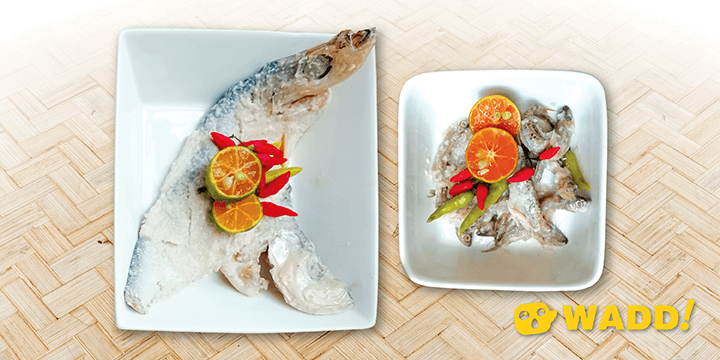
Tikasuom (left), Kauk (right)
Tobah
Tobah is a fermentation technique that uses mushy cooked rice. To do that, rice to water ratio is 1 to 1.5. Tobah does not go well with meat, so mix it with either cassava leaves or any river fish and some salt. Leave it to ferment for 4 to 5 days. After that, you may fry the vegetable with some garlic and anchovies. For fish, you can either fry or steam it! To get mature tobah, keep it fermented for 4 to 6 weeks. You can have tobah raw, or add some lime and chillies for flavouring, and you can also fry it with flour to make a side dish.
Tikasuom
Pound the rice until slightly powdery and grainy; then roast till golden brown. Mix the dry roasted pound rice well with meat (traditionally wild boar), or the Sultan Fish [other types of river fish (ikien sungi) can be used too]. You can also mix it with vegetables like cassava leaves (dowon banuok). To get mature tikasuom, keep it fermented for 4 to 6 weeks. Tikasuom is best serve with some lime and chillies. You can also fry it with flour to make a side dish.
Kauk
Kauk is made from the water from the fermentation of tikasuom. Keep the excess water for 1 to 2 days, and you will have kauk that makes excellent flavouring when you are cooking any fish or meat dish. Feel free to add some chopped red chillies and squeeze some lime to make it that much tastier.
Do You Know?
Here is something interesting when it comes to food fermentation for the community. It is a big no-no (pantang) for Bidayuhs to ferment food when there is a funeral taking place or during menstruation. It is believed that these are factors that can determine the success of the fermentation.
More scrumptious savouries and irresistible flavours from Sarawak! Enjoy these gems and serve it in your kitchen too!
SAMAR SORAI (Sambal Serai/ Lemongrass Sambal)
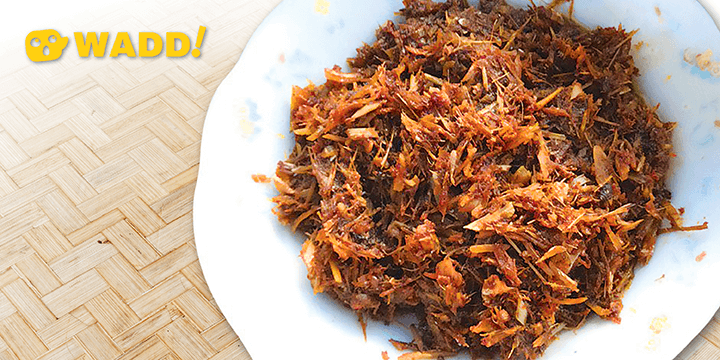
Recommended Ingredients
- 300g Anchovies (Ikan Bilis)
- 2 tablespoon of Shrimp Paste (Belacan)
- 1kg Lemongrass
- 250g Bird’s Eye Chilies
- *Salt to taste
Steps to Prepare
- Clean the lemongrass, slice thinly and pound into a paste.
- Pound chillies and shrimp paste together.
- Heat oil in a pan. Once it is hot enough, fry the anchovies until golden brown. Keep aside.
- Using the same oil, add the pounded lemongrass to fry in the pan. Once it is golden brown, add the pounded chillies and shrimp paste and stir fry until fragrant.
- Finally, add the fried anchovies. Mix well, and it is ready to serve!
PONAS (Grated Tapioca Broth)
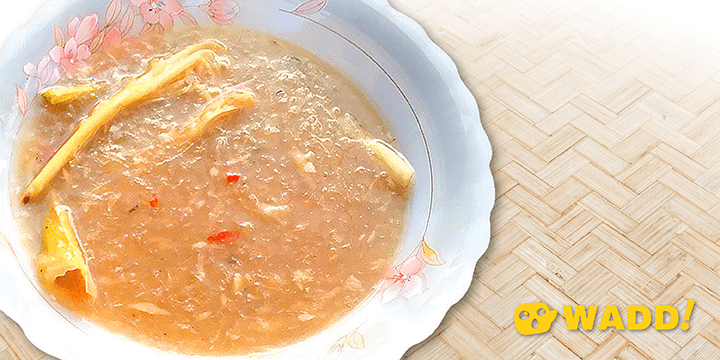
Recommended Ingredients (For 4 – 5 pax servings)
Ingredient A
- 2 Medium Sizes Tapioca (Grated Finely)
- 10 pieces of Tapioca Leaves (Clean and Tear Finely)
- 3-4 pieces of Turmeric Leaves (Clean and Tear Finely)
- 2 stalks of Lemongrass (Clean and Smashed Lightly)
- Water
- *Salt to taste
Ingredient B
- Bird Eye Chilli (Spicy Level of Your Choice)
- A Handful of Anchovies
- 1 tablespoon of Shrimp Paste
- 4 Garlic Cloves
- 3 Shallots
- *Pound all Ingredient B together into a paste
Steps to Prepare
- Boil water in a medium-size pot with the lemongrass.
- Add Ingredient B with tapioca and turmeric leaves into the boiling water.
- Add salt to taste and stir vigorously.
- Add the grated tapioca and stop stirring. Let it simmer.
- You may add toppings such as fried anchovies, garlic or samar sorai.
Recipe and images by Lucille Anak Awen Jon
An Original Of WADD’s (previously Happenings in Sarawak) Article

